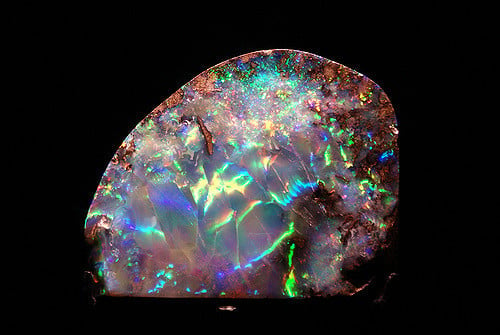What is a Gem?
Even the most general definition of a gem has many exceptions. Learn what qualities have been used to identify gemstones both scientifically and popularly.
3 Minute Read
A Working Definition of a Gem?
The following definition covers the vast majority of the stones we regard as gems:
Minerals that have been chosen for their beauty and durability, then cut and polished for use as human adornment.
Still, every defining feature in that definition has exceptions. This creates problems.
Interested in this topic?
This article is also a part of our Professional Gemologist Certification Course, in the unit An Introduction to Gemology.
Are All Gems Minerals?
Most gems are minerals, but some — notably pearl and amber — are organics. Living organisms create these materials. By definition, a mineral must be created inside the Earth. Hence, pearls fall into a different category. (To add some confusion, a pearl's coating is a mineral, even though pearls form inside a mollusk). Likewise, amber began life as tree sap. After millions of years, it transformed into a polymer, a natural plastic. People have regarded amber as a gem for thousands of years, although it's definitely not a mineral.
Must a Gem Be Beautiful?
Some people would consider gems colored Pepto-Bismol pink and olive green unattractive — like unakite, a variety of epidote. Some find them beautiful. Brown gems enjoy some popularity in "earth tone" jewelry pieces. Of course, others have different tastes. Beauty may be in the eye of the beholder, but do all who choose gems choose beauty? Do all gem enthusiasts select gemstones because they find them beautiful?
How Durable Must Gemstones Be?
For gemstone buyers, durability is usually a high priority. Nevertheless, two very popular gems are particularly delicate. Pearls generally last about a century as jewelry stones due to their softness. The simple act of wiping off dust will slowly wear away their coating. Perfumes and hairsprays can also stain and damage pearls. As ring stones, pearls need protective settings, especially for engagement rings.
Highly valued throughout history, opals are notoriously delicate. As they lose their high water content, they dry out and may crack. They may break with the slightest bump. They're sensitive to changes in temperature, too. I knew one customer who had a prized opal brooch in a protective setting. One night, as she left a Christmas party, the opal shattered with an audible crack as she went from the warmth indoors to the cold winter night. Many have shed tears over opals, and that has even contributed to the belief that opals bring bad luck.
Must All Gems Be Cut and Polished?
So much for beauty and durability. How about cutting and polishing? Currently, many people love using whole crystals or "raw stones" in jewelry. In decades past, this wasn't the case. Mother Nature's crystals can be exceptionally beautiful. Some even believe they have special metaphysical properties that are enhanced when left whole. So, we can't insist that our gems be cut and polished, either.
Can All Gemstones Be Worn as Jewelry?
The last qualification usually associated with a gemstone is its use for adornment. People have cut, polished, and admired about 3,000 minerals. Of these, only about a hundred show up in jewelry. The rest are simply too delicate to wear well and fall strictly in the collector's domain.
A Not Quite Scientific Definition of a Gem
Gemology was first recognized as a science only in the 1930s. Until that time, many people considered all transparent, red gems rubies, blue ones sapphires, and green ones emeralds. Today, as a professional gemologist, I can only call a crystallized beryllium-aluminum silicate with trace amounts of chromium or vanadium an emerald. Other beautiful green gems could be tsavorites, tourmalines, diopsides, and even sapphires.
The allure of gemstones lies in their fantasy of color and light. Beautifully colored stones have intrigued people since time immemorial. The love of gems hasn't changed. However, we now have to contend with a very scientific element. As much as I love the science of gemology, it has the unfortunate side effect of taking much of the mystique and romance out of our stones.
To heck with the definitions. If it makes your eyes light up, it's a true gem!
Donald Clark, CSM IMG
Donald Clark, CSM founded the International Gem Society in 1998. Donald started in the gem and jewelry industry in 1976. He received his formal gemology training from the Gemological Institute of America (GIA) and the American Society of Gemcutters (ASG). The letters “CSM” after his name stood for Certified Supreme Master Gemcutter, a designation of Wykoff’s ASG which has often been referred to as the doctorate of gem cutting. The American Society of Gemcutters only had 54 people reach this level. Along with dozens of articles for leading trade magazines, Donald authored the book “Modern Faceting, the Easy Way.”
International Gem Society
Related Articles
Ring Size Comparison Chart
How Do Tourmalines Form?
Gem Formation: How are Gemstones Created?
What is a Gem Reflectometer?
Latest Articles
800 Years of Mogok: A Celebration in Tenuous Times
What is the Average Gemstone Faceting Yield?
Pyroxmangite Value, Price, and Jewelry Information
How to Identify Emerald Simulants and Synthetics
Never Stop Learning
When you join the IGS community, you get trusted diamond & gemstone information when you need it.
Get Gemology Insights
Get started with the International Gem Society’s free guide to gemstone identification. Join our weekly newsletter & get a free copy of the Gem ID Checklist!
